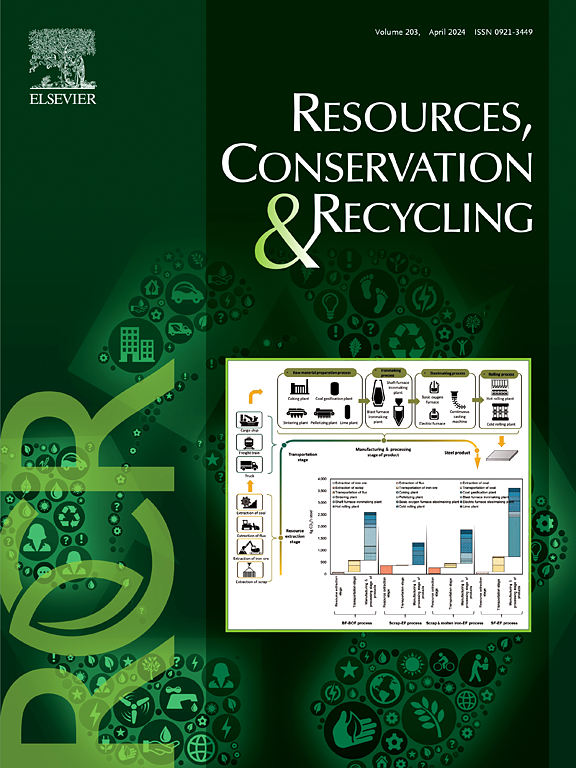从报废锂离子电池中回收有价金属:技术、进展和前景
IF 10.9
1区 环境科学与生态学
Q1 ENGINEERING, ENVIRONMENTAL
引用次数: 0
摘要
随着电动汽车和电子产品对锂离子电池的需求不断增加,从废旧锂离子电池(SLIBs)中回收有价金属从经济和环境的角度来看变得至关重要。然而,在开发可持续技术以推进SLIBs贵重金属价值链方面缺乏整体观点。因此,本文系统地考察了现有的slib金属回收上下游技术,以了解这些技术的发展趋势。在上游回收方面,讨论了火法冶金技术的发展趋势,并对湿法冶金技术的应用进行了综合分析。建议采用合成生物学手段和代谢工程技术提高生物湿法冶金工艺中微生物的耐受性。我们提出了一个串联的生物和热液浸出工艺可以实现从SLIBs中稳健高效的金属浸出。下游分离技术在金属离子的分离中起着举足轻重的作用。膜技术对SLIBs渗滤液中特定金属离子和酸的选择性分离进行了广泛的比较。尽管膜技术在环境友好方面比工业溶剂萃取和沉淀方法具有独特的优势,但选择性和成本之间的不平衡限制了膜技术的商业化。总结了传统膜工艺和新兴膜工艺的主要特点。本文通过对工业SLIBs回收业务现状和趋势的分析,提出了基于全价值链的技术发展和产业化前景。最终,本综述通过采用更具可持续性和成本效益的技术,将SLIBs中有价金属的回收利用提升到更高的创新水平。本文章由计算机程序翻译,如有差异,请以英文原文为准。

Recovery of valuable metals from end-of-life Li-ion batteries: Technologies, progress, and perspectives
With the increasing demand for Li-ion batteries in electric vehicles and electronics, the recovery of valuable metals from spent Li-ion batteries (SLIBs) becomes crucial from both economic and environmental perspectives. However, there is a lack of holistic perspectives on developing sustainable technologies to advance the value chain of valuable metals from SLIBs. Thus, this review has systematically examined existing upstream and downstream technologies for metals recovery from SLIBs to figure out the trends of these technologies. For upstream recovery, the evolution of pyrometallurgical techniques was discussed, while applications of hydrometallurgical methods were comprehensively analyzed. Synthetic biology tools and metabolic engineering were recommended to enhance the tolerance of microorganisms in biohydrometallurgy towards its industrialization. We proposed that a tandem biological and hydrothermal leaching process could realize a robust and highly efficient metal leaching from SLIBs. Downstream separation technologies play a pivotal role in fractionation of metal ions. Membrane technologies are extensively compared for selective separation of specific metal ions and acids from SLIBs leachate. Despite the unique advantage in environmental friendliness over industrial solvent extraction and precipitation methods, an imbalance between selectivity and cost limits the commercialization of membrane technologies. Key features were specifically concluded for both conventional and emerging membrane processes. Through the analysis of the state-of-the-art and trends of industrial SLIBs recycling business, this review offers promising outlooks on technological development and industrialization based on the entire value chain. Eventually, this review promotes the recycling of valuable metals from SLIBs to a higher innovation level by adopting more sustainable and cost-efficient technologies.
求助全文
通过发布文献求助,成功后即可免费获取论文全文。
去求助
来源期刊

Resources Conservation and Recycling
环境科学-工程:环境
CiteScore
22.90
自引率
6.10%
发文量
625
审稿时长
23 days
期刊介绍:
The journal Resources, Conservation & Recycling welcomes contributions from research, which consider sustainable management and conservation of resources. The journal prioritizes understanding the transformation processes crucial for transitioning toward more sustainable production and consumption systems. It highlights technological, economic, institutional, and policy aspects related to specific resource management practices such as conservation, recycling, and resource substitution, as well as broader strategies like improving resource productivity and restructuring production and consumption patterns.
Contributions may address regional, national, or international scales and can range from individual resources or technologies to entire sectors or systems. Authors are encouraged to explore scientific and methodological issues alongside practical, environmental, and economic implications. However, manuscripts focusing solely on laboratory experiments without discussing their broader implications will not be considered for publication in the journal.
 求助内容:
求助内容: 应助结果提醒方式:
应助结果提醒方式:


